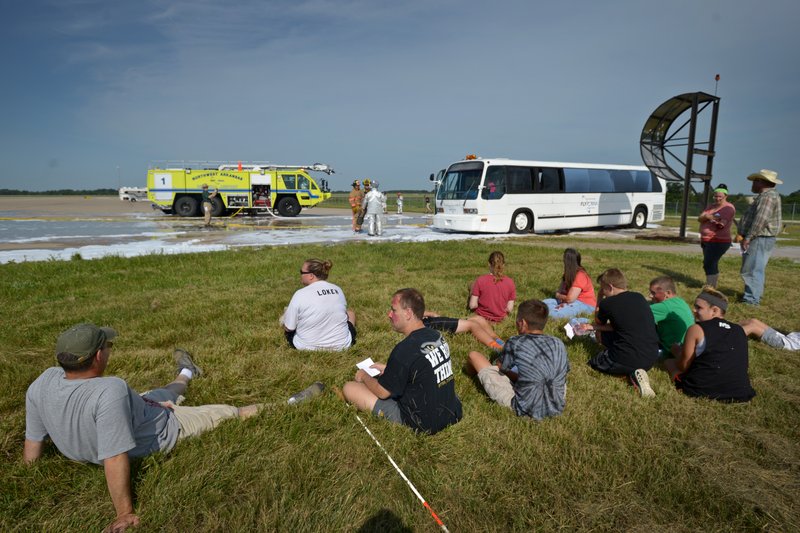HIGHFILL -- Faithe Lyons shuffled through foam Saturday as she followed a trail of volunteers acting as victims during an emergency drill at Northwest Arkansas Regional Airport in Highfill.
"My arm is gone, my arm is gone," Lyons whimpered as firefighters from multiple departments helped survivors to a grassy patch. Lyons wore an artificial arm that appeared to be severed.
Lyons was one of more than 60 volunteer "victims" of a simulated plane crash for Saturday's drill.
An airport shuttle bus stood in for the crashed plane. Two crushed cars sat feet away, acting as parts of the plane that flew off in the crash.
Gilbert Neil, Northwest Arkansas Regional's public-safety director, said the Federal Aviation Administration requires airports to conduct large emergency drills such as Saturday's every three years.
"We hold these to gain experience," Neil said. "We want to get our response right."
The Benton County Emergency Management Agency teamed with the airport for the drill, agency director Mike Dixon said. At least 12 fire departments from the region participated in the event, he said.
The airport's Fire Department responded to the simulated crash by spraying foam across the scene. Neil said it was the first time foam has been used in a drill at the airport, and he warned responders and actors to be careful on the slick surface.
Highfill firefighters helped evacuate the bus, while Decatur firefighters broke windows out of the crushed cars to free mannequins inside. Across the airport apron, Centerton firefighters were assessing the "victims" as they were moved away from the scene.
Lyons' role ended quickly, as firefighters decided her character needed to be transported by helicopter to a hospital. After her character's exit, she was left to sit on the sidelines watching the rest of the event as it unfolded.
"It was a lot of fun," Lyons said. "It also was creepy to see what a real-life emergency would look like."
Temperatures during the drill kept the responders alert to real problems, Dixon said. A heat advisory was in place Saturday for Northwest Arkansas, with the National Weather Service predicting a heat index of 105 degrees or higher.
One firefighter was treated for heat stress during the drill, Dixon said. He said the firefighter was moved to an ambulance where he could cool off and receive fluids.
"Elements are always something that is a contributing factor," Dixon said. "It is another issue the people in the exercise have to think about."
Firefighters wear heavy gear, which makes it even more important to be aware of conditions such as extreme heat, Dixon said.
Dixon said the two-hour drill was a way for officials to evaluate how to improve the response to prepare for any real emergencies. He said that could mean better communication or a smoother process for treating patient surges.
Neil said officials would meet this week to discuss the strengths and weaknesses observed during the exercise.
Metro on 08/09/2015
